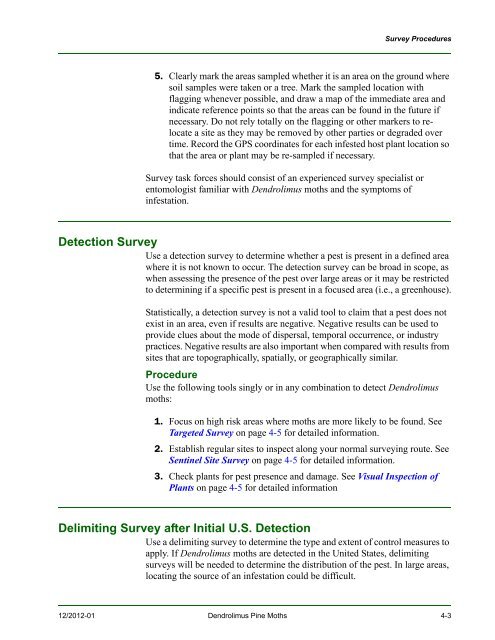New Pest Response Guidelines - aphis - US Department of Agriculture
New Pest Response Guidelines - aphis - US Department of Agriculture
New Pest Response Guidelines - aphis - US Department of Agriculture
You also want an ePaper? Increase the reach of your titles
YUMPU automatically turns print PDFs into web optimized ePapers that Google loves.
Survey Procedures<br />
5. Clearly mark the areas sampled whether it is an area on the ground where<br />
soil samples were taken or a tree. Mark the sampled location with<br />
flagging whenever possible, and draw a map <strong>of</strong> the immediate area and<br />
indicate reference points so that the areas can be found in the future if<br />
necessary. Do not rely totally on the flagging or other markers to relocate<br />
a site as they may be removed by other parties or degraded over<br />
time. Record the GPS coordinates for each infested host plant location so<br />
that the area or plant may be re-sampled if necessary.<br />
Survey task forces should consist <strong>of</strong> an experienced survey specialist or<br />
entomologist familiar with Dendrolimus moths and the symptoms <strong>of</strong><br />
infestation.<br />
Detection Survey<br />
Use a detection survey to determine whether a pest is present in a defined area<br />
where it is not known to occur. The detection survey can be broad in scope, as<br />
when assessing the presence <strong>of</strong> the pest over large areas or it may be restricted<br />
to determining if a specific pest is present in a focused area (i.e., a greenhouse).<br />
Statistically, a detection survey is not a valid tool to claim that a pest does not<br />
exist in an area, even if results are negative. Negative results can be used to<br />
provide clues about the mode <strong>of</strong> dispersal, temporal occurrence, or industry<br />
practices. Negative results are also important when compared with results from<br />
sites that are topographically, spatially, or geographically similar.<br />
Procedure<br />
Use the following tools singly or in any combination to detect Dendrolimus<br />
moths:<br />
1. Focus on high risk areas where moths are more likely to be found. See<br />
Targeted Survey on page 4-5 for detailed information.<br />
2. Establish regular sites to inspect along your normal surveying route. See<br />
Sentinel Site Survey on page 4-5 for detailed information.<br />
3. Check plants for pest presence and damage. See Visual Inspection <strong>of</strong><br />
Plants on page 4-5 for detailed information<br />
Delimiting Survey after Initial U.S. Detection<br />
Use a delimiting survey to determine the type and extent <strong>of</strong> control measures to<br />
apply. If Dendrolimus moths are detected in the United States, delimiting<br />
surveys will be needed to determine the distribution <strong>of</strong> the pest. In large areas,<br />
locating the source <strong>of</strong> an infestation could be difficult.<br />
12/2012-01 Dendrolimus Pine Moths 4-3

















